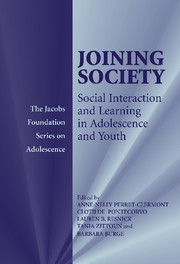Book contents
- Frontmatter
- Contents
- List of Contributors
- Foreword
- Preface
- I Introduction
- II Youth-Constructed Socialization
- III Personal Agency Through Collective Activity
- IV Learning in Practice and Discourse
- V Intergenerational Sites for Thinking
- VI Pathways to Adulthood in National Context
- 19 Joining Society in Europe: Convergence or Sustainability of National Specificities
- 20 The School-to-Work Transition: Problems and Indicators
- 21 To Be Young in Yugoslavia: Life After a Social Chernobyl
- 22 Youth and Unions in North America's Service Society
- 23 Joining Society: With What Certainty?
- Index
- References
23 - Joining Society: With What Certainty?
Published online by Cambridge University Press: 08 January 2010
- Frontmatter
- Contents
- List of Contributors
- Foreword
- Preface
- I Introduction
- II Youth-Constructed Socialization
- III Personal Agency Through Collective Activity
- IV Learning in Practice and Discourse
- V Intergenerational Sites for Thinking
- VI Pathways to Adulthood in National Context
- 19 Joining Society in Europe: Convergence or Sustainability of National Specificities
- 20 The School-to-Work Transition: Problems and Indicators
- 21 To Be Young in Yugoslavia: Life After a Social Chernobyl
- 22 Youth and Unions in North America's Service Society
- 23 Joining Society: With What Certainty?
- Index
- References
Summary
The Deinstitutionalization of Life Paths
In all Western countries, the dynamics of demographic trends indicate that the past few decades have seen a substantial increase in life expectancy. This structural change has been accompanied by other changes, with obvious repercussions on people's ways of living and on their conception of the social system, the labor market, and the culture of civil society.
Research on the subject (see references in Ritter, 1997) has long dwelled on the implications of changes in the length, structure, and level of standardization of people's lives in the past century. One study in particular (Saraceno, 1991) has identified two processes covering different periods of time: an initial process whereby the structure and chronology of the lives of individuals and social groups became increasingly standardized as a result of demographic and normative institutionalization and regularization; and a later process, still underway, whereby previously established standardized models are being deregulated.
The first of these two processes – the institutionalization of life paths – began slowly, strengthened itself, and became consolidated in the 1950s and 1960s. It was the result of various interconnected phenomena, including increased control over life paths by the labor market, enterprises, and the state through the introduction of regulations on the structure, periods, and specific ages for choices of life and events. We can cite, for example, the definition of specific ages at which people entered and left the labor market, of minimum ages at which people could enter and leave the education system, and of minimum ages at which people could get married and assume mutual duties between spouses and among generations as established by law.
- Type
- Chapter
- Information
- Joining SocietySocial Interaction and Learning in Adolescence and Youth, pp. 318 - 328Publisher: Cambridge University PressPrint publication year: 2003



